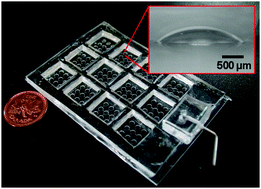Aortic valve homeostasis is mediated by valvular interstitial cells (VICs) found in spatially distinct and mechanically dynamic layers of the valve leaflet. Disease progression is associated with the pathological differentiation of VICs to myofibroblasts, but the mechanobiological response profiles of cells specific to different layers in the leaflet remains undefined. Conventional mechanically dynamic macroscale culture technologies require a large number of cells per set of environmental conditions. However, large scale expansion of primary VICs in vitro does not maintain in vivo phenotypes, and hence conventional macroscale techniques are not well-suited to systematically probe response of these cell types to combinatorially manipulated mechanobiological cues. To address this issue, we developed a microfabricated composite material screening array to determine the combined effects of dynamic substrate stretch, soluble cues and matrix proteins on small populations of primary cells. We applied this system to study VICs isolated from distinct layers of the valve leaflet and determined that (1) mechanical stability and cellular adhesion to the engineered composite materials were significantly improved as compared to conventional stretching technologies; (2) VICs demonstrate layer-specific mechanobiological profiles; and (3) mechanical stimulation, matrix proteins and soluble cues produce integrated and distinct responses in layer-specific VIC populations. Strikingly, myofibroblast differentiation was most significantly influenced by cell origin, despite the presence of potent mechanobiological cues such as applied strain and TGF-β1. These results demonstrate that spatially-distinct VIC subpopulations respond differentially to microenvironmental cues, with implications for valve tissue engineering and pathobiology. The developed platform enables rapid identification of biological phenomena arising from systematically manipulating the cellular microenvironment, and may be of utility in screening mechanosensitive cell cultures with applications in drug screening, tissue engineering and fundamental cell biology.

You have access to this article
 Please wait while we load your content...
Something went wrong. Try again?
Please wait while we load your content...
Something went wrong. Try again?


 Please wait while we load your content...
Please wait while we load your content...